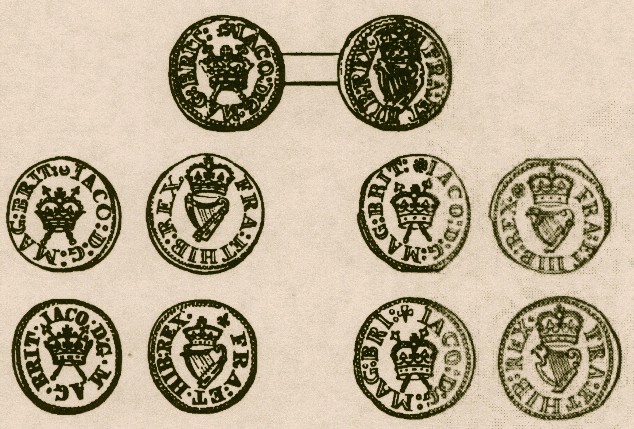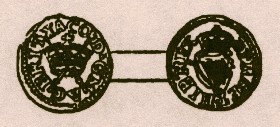

but was not adopted. Harrington farthings or tokens were then coined, and were so called from the fact that the
original patent was granted to Lord Harrington of Exton, in the county of Rutland, who secured a portion of the
profits of the issue, the remainder being reserved for the King. This patent was granted in 1613. As each coin
was to weigh six grains, the profit was immense, and the difference between the nominal and the intrinsic value
was so great that forgeries were of the utmost prevalence. Lord Harrington died a few months after the patent
was granted, and his son and successor shortly afterwards, and a second grant was made to Lady Anne Harrington,
the widow of the first patentee. This was followed by a grant to the Duke of Lenox and others. Gerard
Malynes and William Cockayne at first, and subsequently others, became the contractors for the issue. These
tokens bear:
The legend on the obverse of these coins, with the one exception afterwards mentioned, commences at the top. These
pieces have been thought to have been intended for circulation in Ireland, but this was evidently not the case.
the mint mark generally appears on the obverse only, but in some few cases on both sides. Among the latter I have observed
those with the m. m. Cross, Flower, Fusil and Rose. The mintmarks appearing on the obverse only are as follows:
As will appear from the preceding illustrations, the shape of the harp also differs on various Coins; some have
the bird's head in profile, others, the full face, and others have no bird's head at all. There are variations
in the sizes of these coins.
In my own cabinet, and in that of Mr. J. B. Caldecott, are examples of a somewhat oblong shape on which the harp
has a bird's head and the m. m. on both sides is a small cross. The legend IACO. D. G. MAG. BRI commences
to the left at the bottom of the coin, and a pellet occurs between the ends of the sceptres. The reverse legend
is FRA. ET. HIB. REX.; of this piece there is an imperfect representation in Simon, Pl. 6,
No. 128, but Snelling (Copper Coinage, p. 8) considered this an error, as he had never seen one.
A small piece half the size of the ordinary token was considered by Snelling to have been a half-farthing, but
was more probably the result of an attempt still further to impose upon the public. Its rarity affords some
evidence that such attempt was successful but for a very short period.
This coin weighs four grains or thereabouts.
This seems almost to justify Snelling's conjecture, as although the patentees were entitled to coin farthings
of the weight of 6 grains, the larger pieces, when well-preserved, weigh from 8 to 8½ grains, and although
no half-farthings were authorized they were certainly mentioned in one of the previous applications to the King
on the subject of the coinage. This token is generally found silvered, and between the sceptres and immediately
under the crown will be found on some of them a minute capital letter. Of these A B C D E F O and
Z have been observed.
The Z(?) may be the figure 2, in which case the O is also a figure, and one may
expect to find the figure 1 on an example, as these three mint marks occur on the gold and silver coinage
of Elizabeth, and the figure 1 occurs on as a mint mark on a farthing (Type 1) of Charles I.
The only mint mark is a fret, which occurs on the reverse only. The fret clouée as this is, was a charge
on the Harrington Arms, and is in heraldry sometimes called the Harrington Knot. There are some pieces of a size
intermediate between that of the the ordinary tokens and that of the farthings last mentioned, and they
resemble these last in the fact that the mint marks, of which the saltire cross, cinquefoil, lis (large and small)
and trefoil only have hitherto been observed by me, occur on the reverse only. One of slightly larger module
and with a slight difference in the position of the word IACO bears the m. m. bell. The m. m.
fret never occurs on these or the larger pieces. It may be further noted that the harp on the larger coins has
five or six strings, but that on the intermediate and small pieces, has seven or eight. Notwithstanding the order in
which I have placed these tokens, and the observations I have made in connection with them, I am bound to admit
that, but for the question of weight, it would be more reasonable to suppose that the smallest pieces were coined first,
those of the intermediate size next, and the large pieces last, and in support of this contention could be urged the fact
that it is more probable that those with the Harrington fret should have been the first issue, particularly as
the last holder of the patent was not a Harrington at all; and secondly, and perhaps with equal force, it might
be argued that as the larger pieces are almost identical in size and workmanship with the earliest tokens issued
by Charles I., it is much more probable that they formed part of the latest issue of his predecessor. The
deficiency in weight of the smaller pieces would in that event be fairly supposed to have been the result of a
first attempt at imposition, which was gradually remedied, until an issue of the full weight authorized was secured.
The coins themselves were exceedingly unpopular. They were poor in workmanship, and inconvenient on account of
their small size and extreme thinness. Counterfeits swarmed, and it needed numerous proclamations to obtain
for them even a limited currency.
The literature of the time is full of disparaging allusions to them, and they were at last hawked
through the Kingdom by parcels of £20. each, to the mayors of cities and boroughs, who were commanded
to put them into circulation at a discount, and to remit the money realized to the before named
Gerard Malynes.
During this and the following reign, slips of copper occur with more than one token stamped thereon
by way of trial. As many as four on one slip have occurred, and from this it may be inferred that the
tokens were struck in the first instance on sheet copper, and were subsequently cut out.
The Copper, Tin, and Broze Coinage of England
H Montagu, F.S.A, , 1893
James I
James I. 1603-1625
This monarch had seen the advantage of a copper coinage in Scotland, and the beneficial result of the
royal issue in Ireland of copper coins bearing date 1601 and 1602. A pattern,
presumably for a copper piece, was struck early in his reign.
1. O. I. R. crowned. To the left an expanded rose between two pellets, to the right a thistle with
pellets as before. Below the initials is a small rose between two pellets.
R. A portcullis crowned. R. 6.
2. O. A crown over two sceptres more or less in saltire. IACO. D. G. MAG. BRI. (or BRIT.)
R. A crowned harp. FRA. ET. HIB. REX. Common.

[unbarred A with bar at apex]
Annulet
Ball
Bell
Boar's head
Cinquefoil
Comet
Crown
Crescent
Cross
Small ditto
St. George's Cross surmounting St. Andrews's cross
Dagger
Inverted ditto
Eagle's head erased
Fret
Fusil
Fleur de lys
Three ditto
Flower
Grapes
Key
Lion rampant
Lion passant
Lozenge
Martlet
Mullet pierced
Pellet
Quatrefoil
Rose
Serpent?
Star
Stirrup
Sword
Thistlehead
Tower
Tun
Trefoil
Two inverted trefoils
Triangle